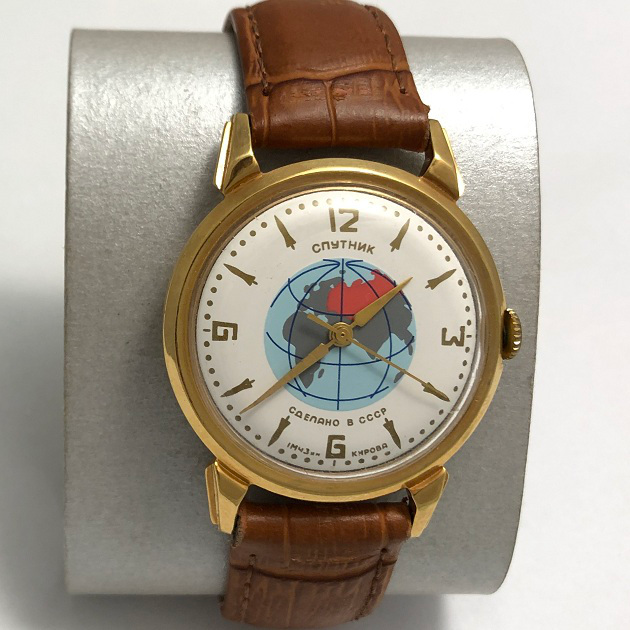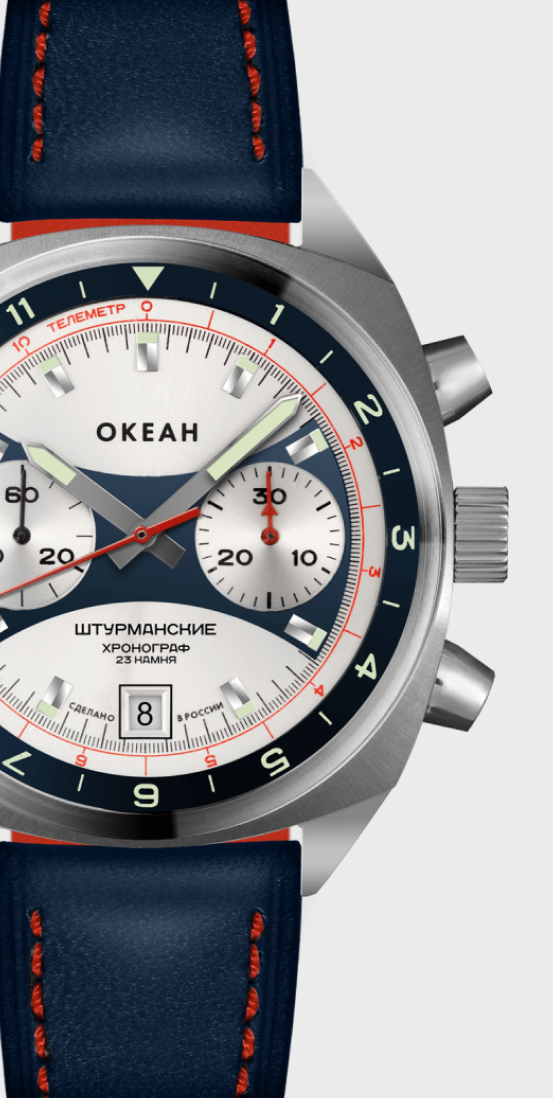“Sturmanskie” watch collection: heritage and new watch models.
 The Beginning of History
The Beginning of History
The “Sturmanskie” brand today is a heritage and an achievement of the 1st Moscow Watch Factory (1 MChZ). So, in order to appreciate the present and future of “Sturmanskie“, it is worth learning about the past of the Soviet watch industry.
The 1st State Watch Factory was founded in 1930. Later, we will tell you all about its manufacturing development history, but now let's immediately start from the second half of the 1940s, when it was just renamed as the 1st Moscow Watch Factory...
After World War II, the Soviet government set ambitious goals for the country on a global scale: to explore the ocean, the North and South Poles, and space.
Therefore, the very first world explorers, observed by millions of eyes around the planet, required high quality equipment, one of which was a wristwatch, reliable and suitable for the most extreme conditions.
In order to solve this problem, a technological breakthrough was made and in just 10-20 years a watch series that could withstand the highest levels of pressure and always show the exact time was created.
Now, let's go over the major milestones of this path and see the best things that have been carefully preserved and implemented in today's collections…
“Sturmanskie” — “Gagarin”
After the war, the first legendary watch model produced by the First Moscow Watch Factory was the "Sturmanskie". It was that time when the factory gained the reputation of a watch supplier under special government order.
These watches, made for pilots and navigators, had to work flawlessly in overload, pressure and temperature fluctuation conditions. The watches weren’t publicly sold and were only issued to graduates of flight academies and crews of aviation divisions.
The very first "Sturmanskie" type I produced in 1949 was powered by an original 15-jewels movement, the prototype of which was the K-26 of "Pobeda" watches. It was a manual winding movement with a central second hand, good power reserve, high accuracy, and a stop-second function, which was important for pilots allowing them to synchronize their actions.

Five years later, "Sturmanskie" type II watch (17 jewel movement) was produced with improved technical characteristics including higher shockproof protection and dust and moisture resistance. In fact, this exact type of watch was given to Yuri Gagarin when he graduated from the military flying school in Orenburg, and soon after gained world fame as the first watch in space.
 It’s worth mentioning that Gagarin was not the only cosmonaut wearing Sturmanskie. The watches were issued to all future space conquerors, worked perfectly in unpredictable and difficult conditions and were used by participants of the first group spaceflight in 1962, the first woman cosmonaut Valentina Tereshkova in 1963, and the first scientific expedition beyond the atmosphere in 1964. Lastly, the watches also served to cosmonauts from other countries involved in the international space program.
It’s worth mentioning that Gagarin was not the only cosmonaut wearing Sturmanskie. The watches were issued to all future space conquerors, worked perfectly in unpredictable and difficult conditions and were used by participants of the first group spaceflight in 1962, the first woman cosmonaut Valentina Tereshkova in 1963, and the first scientific expedition beyond the atmosphere in 1964. Lastly, the watches also served to cosmonauts from other countries involved in the international space program.
These watches became an epoch of the both - the watch industry and the space odyssey - which is why all new collections also gained their “Sturmanskie” name and one of the flagships - “Gagarin” Collection, which models inherited all the aesthetics of the Soviet "Sturmanskie", features and the logic of designers.
 “Gagarin The First” model is the closest version of "Sturmanskie" Type I: diameter 33 mm, authentic hands and crown shape, austere and noble appearance. Powered by the classic Soviet 2609 Poljot movement.
“Gagarin The First” model is the closest version of "Sturmanskie" Type I: diameter 33 mm, authentic hands and crown shape, austere and noble appearance. Powered by the classic Soviet 2609 Poljot movement. “Gagarin Heritage“ is also a slightly modified version of the Soviet watch: it has a 40 mm diameter, a wide range of color combinations, and is powered by two types of movements: a mechanical (2609 Poljot) and automatic (2416 Vostok). The memory of history is reflected on the caseback, which is decorated with a portrait of Yuri Gagarin.
“Gagarin Heritage“ is also a slightly modified version of the Soviet watch: it has a 40 mm diameter, a wide range of color combinations, and is powered by two types of movements: a mechanical (2609 Poljot) and automatic (2416 Vostok). The memory of history is reflected on the caseback, which is decorated with a portrait of Yuri Gagarin.
In 2021 the new "Gagarin 60 years" anniversary model with a commemorative inscription was produced as the memory of the first human space flight.

The "Gagarin" collection also includes options for fans of certain functional features and accents, united by recognizable features of the original watch.
The "Gagarin Classic" and "Gagarin Classic 33" are watches with a laconic geometric design and precise details.
"Gagarin 24 Hours" - 44 mm watch with precise lines and bright colors, 2 time scales, a second time zone, and a date display. Back cover is decorated with a map of the world symbolizing that the watch will be a reliable assistant to its owner at any time and anywhere in the world.
"Gagarin Day-Night" is a practical watch with an expressive appearance, high water resistance, 2 time zones, 12/24 hour scales, and a date indicator.
 “Sputnik”
“Sputnik”In 1957, the First Moscow Watch Factory produced the “Sputnik” wristwatch for men. This event was timed to coincide with the launch of the first artificial Earth satellite in October of that year.

The design of the watch was appropriate: the dial displays a blue globe with the USSR marked in red, part of the numbers are replaced by signs in the rocket form. Two versions were manufactured: one with classic second hand and one without it, replaced by a red marker in the form of a satellite, moving on a transparent disk on the red "orbit". For all its decorative qualities, the watch had a power reserve of 34 hours and high precision.
Unfortunately, "Sputnik" watches had a very limited edition, that is why they are a rarity and the pride of collectors. Today "Sturmanskie" produces a "Sputnik" collection to correct this injustice and secure the memory of the momentous event.
One of its pieces, the “Sputnik Heritage” watch, which is the closest version of the original design idea from 1957 and powered by the traditional Soviet mechanism 2609 Poljot.

The design of other watches in the collection is also inspired by the idea of satellite flights, and their functionality differs.
"Sputnik GMT" is suitable for avid travelers: it has a second time zone setting with a 24-hour scale, a window with a date, and a large battery capacity.
"Sputnik Heritage Small Seconds" are distinguished by understated elegance, purity of lines, a wide variety of colors, and a small inner dial with a second hand adds zest to them.
Polar Watches - "Arktika"
As the First Moscow Watch Factory continued special purpose watch manufacturing suitable for use in the harshest conditions, a limited series of watches were produced. These included “Antarctica" (1957, in honor of the first expedition to the South Pole), “North Pole“ (1957) and simply the “Pole“ (early 1960s).

They were created for the North and South Poles explorers, weren’t sold publicly, and were only issued to polar explorers and other workers in this field. Such watches, as a rule, had a dust-tight case, special antimagnetic screens inside it, 24-hour dial, luminous hands and marks.
The modern watches of "Sturmanskie Arktika" collection also withstand high loads, have a high degree of protection against any external influences, and therefore are in demand among the Russian polar explorers and researchers.
 The collection also includes a 24-hour dial watch "Arktika Heritage 24 Hours" that allows you to tell the time of day no matter where you are.
The collection also includes a 24-hour dial watch "Arktika Heritage 24 Hours" that allows you to tell the time of day no matter where you are.
Another piece is “Arktika Heritage Automatic”, has a familiar dial, but also has a 24-hour scale. The "Arktika Day-Night" watch has two time scales and allows you to navigate in two time zones at once.
"Strela” (Translated as “Arrow”) - “Open Space”
Returning to Soviet achievements in the sky. In 1965, the First Moscow Watch Factory’s watch "Strela” was on the wrist of cosmonaut Alexei Leonov during his historic first spacewalk for more than 12 minutes.
"Strela” was the first mass-produced Soviet wrist chronograph. The watch has been produced since 1959 and was based on the Swiss Venus caliber but has been significantly upgraded. The chronograph was equipped with a one-shot stopwatch and a 45-minute counter, telemeter and tachometer scales.
 "Strela" was originally designed for Air Force command staff (although there are indications that the watch appeared among civilians as well), and was produced for about 20 years and during this period replaced the first “Sturmanskie” types on the hands of pilots and cosmonauts.
"Strela" was originally designed for Air Force command staff (although there are indications that the watch appeared among civilians as well), and was produced for about 20 years and during this period replaced the first “Sturmanskie” types on the hands of pilots and cosmonauts.
In honor of the first outstanding cosmonauts of that period, Alexei Leonov, his partner Pavel Belyaev and their colleagues who participated in the first space expeditions, Sturmanskie produces a series of "Open Space" watches.
Watches of this collection are united by courageous design, consistency of lines, recognizable details and aesthetics of the best Soviet watches for sky conquerors.

A variety of colors and textures, functional characteristics and famous movements makes it even possible to customize each model. There are watches with one or two time scales, 24-hour watches, watches with an audible alarm, with a miniature internal seconds dial, and those indicating a date and a day of the week.
In addition, there are 2 chronographs in the collection: "Open Space Chronograph Automatic" and "Open Space Chronograph Heritage."
We will pay special attention to the second chronograph because it is produced using the very famous movement 3133 which will be discussed below.
"Ocean"
By the end of the 70s, 3017 caliber used in chronographs was replaced by a simpler to manufacture and less capricious in maintenance movement 3133, which soon became widespread and became the pride of the First Moscow Watch Factory and the entire Soviet watch industry. It has been used till today.
For its creation in 1974, the equipment, rights and documentation for the Swiss Valjoux 7734 movement were purchased. However, the Soviet designers significantly improved it, making it more reliable and accurate. The team of developers was awarded the State Prize for this work.
In 1976, the first watch powered by this movement, the “Ocean” chronograph for naval officers, and soon afterwards the Naval chronograph for the Air Force were produced with the same movement. It had a solid stainless steel case with reflective hands and indexes, a stopwatch, a time counter and a date display. The movement was later supplemented with a stop-seconds function and became known in this modification as No. 31659.
 As stated before, these watches were initially produced only for the army by government order. However, in 1983, watches powered by the 3133 movement went on sale as "Poljot", with some "civilian" differences: a different design and a case made of brass.
As stated before, these watches were initially produced only for the army by government order. However, in 1983, watches powered by the 3133 movement went on sale as "Poljot", with some "civilian" differences: a different design and a case made of brass.
The watch with 3133 caliber also marked the history of space exploration as it was worn by Valery Polyakov during his record-breaking stay in space in 1994-1995 (for more than 437 days). The caliber has gained recognition among cosmonauts not only in Russia, but also abroad. In 1990, the first Japanese journalist in space Toyohiro Akiyama visited the MIR space station wearing a watch No. 31659.
Today "Sturmanskie" produces a mechanical chronograph "Ocean 3133", which repeats the extraordinary design of "Ocean" of the 1970s and is based on the same movement.

The “Ocean” collection also includes watches with special features crucial to divers and sailors as well as a distinctive design and large, brightly colored dial elements clearly visible underwater: the Ocean “Amphibia” with 20 atm water resistance and the “Ocean Stingray” with 30 atm water resistance.
The Future in Space: Heading to the Moon and Mars
In today's watches, you can find the best practices of the past, but also a plan for the future.
Humanity has always been striving to explore spaces beyond our planet, and it certainly will succeed. The Moon and Mars are the main targets that the international space community is working on now.
Russia's current lunar program is launching the automatic station “Luna-25” to the Earth satellite to conduct scientific research. The launch is scheduled for 2022.
The Sturmanskie "Luna 25" watch collection is inspired by this important mission. It is a limited edition men's chronograph, with an image of the moon on a dial and fantasy bas-relief of the Russian station landed on the satellite of our planet on the back cover.
 “Mars” watch is another cherished dream of extraterrestrial explorers. The Sturmanskie “Mars" collection for men and women features a futuristic design combining bright red elements as the main association with the unapproachable Red Planet and a set of modern shockproof measures, vibration and moisture protection, allowing the watch to be suitable for extreme conditions on Earth and in space.
“Mars” watch is another cherished dream of extraterrestrial explorers. The Sturmanskie “Mars" collection for men and women features a futuristic design combining bright red elements as the main association with the unapproachable Red Planet and a set of modern shockproof measures, vibration and moisture protection, allowing the watch to be suitable for extreme conditions on Earth and in space.
Hopefully we will be able to use our watches to record the time when a man will set foot on the Moon and Mars in the very near future. Our watchmakers will make sure that this moment will be recorded as accurately as possible.























